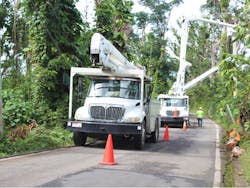An initiative led by PathStone and The Solar Foundation has selected Castañer, Puerto Rico, as the location for a new solar microgrid.
The small, rural community of Castañer was chosen from a group of nine candidates to receive funding from the Puerto Rican Solar Business Accelerator, which is backed by the United States Economic Development Administration.
Designed to improve Castañer’s access to reliable electricity, the new microgrid will incorporate solar energy generation and battery storage to provide power for the town’s essential businesses.
In 2017, residents of Castañer were without electricity for six months in the aftermath of Hurricane Maria. The new microgrid will not only increase the community’s energy resilience but will also add up to 120 local positions for residents in the solar workforce.
Both The Solar Foundation and the Microgrid Laboratory at the University of Puerto Rico in Mayagüez will provide direct support to Castañer solar developers, assisting with project design, project management, request for proposal drafting and presenting sustainable financing options.
To reduce the total cost of the project, The Solar Foundation plans to donate roughly $40,000 worth of solar equipment.
Castañer residents have teamed up with the Hydroelectric Cooperative of La Montaña to represent the community during the initial planning and development stages.
The microgrid is currently planned for completion in the fall of 2021. In addition to providing power during emergencies, the main goal of the project is to supply clean, low-cost electricity to the people of Castañer.
The Castañer microgrid is one of several in development on the island after the Puerto Rico Energy Bureau mandated a new utility integrated resource plan in 2020.
The Solar Foundation is planning to announce a second microgrid that will be supported by Puerto Rican Solar Business Accelerator resources and funding.
Track news about solar microgrid projects by subscribing to the free Microgrid Knowledge Newsletter.







